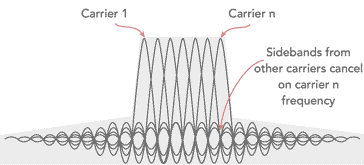What is Multicarrier Modulation
Multicarrier modulation is a form of signal waveform that uses multiple normally close spaced carriers in a block to carry the information.
Home » Radio & RF technology » this page
Multicarrier Modulation Includes:
Multicarrier modulation basics
See also:
OFDM basics
What is FBMC
Multicarrier modulation, MCM is a technique for transmitting data by sending the data over multiple carriers which are normally close spaced.
Multicarrier modulation has several advantages including resilience to interference, resilience to narrow band fading and multipath effects.
As a result, multicarrier modulation techniques are widely used for data transmission as it is able to provide an effective signal waveform which is spectrally efficient and resilient to the real world environment.

Multicarrier modulation basics
Multicarrier modulation operates by dividing the data stream to be transmitted into a number of lower data rate data streams. Each of the lower data rate streams is then used to modulate an individual carrier.
When the overall transmission is received, the receiver has to then re-assembles the overall data stream from those received on the individual carriers.
It is possible to use a variety of different techniques for multicarrier transmissions. Each form of MCM has its own advantages and can be sued in different applications.
Development of MCM
The history of multicarrier modulation can said to have been started by military users. The first MCM were military HF radio links in the late 1950s and early 1960s. Here several channels were sued to overcome the effects of fading.
Originally the concept of MCM required the use of several channels that were separated from each other by the use of steep sided filters of they were close spaced. In this way, interference from the different channels could be eliminated.
However, multicarrier modulation systems first became widely used with the introduction of broadcasting systems such as DAB digital radio and DVB, Digital Video Broadcasting which used OFDM, orthogonal frequency division multiplexing. OFDM used processing power within the receiver and orthogonality between the carriers to ensure no interference was present.
Later OFDM was used for systems such as wireless / cellular telecommunications and networking standards including WiMAX, Wi-Fi 802.11, and also LTE, the Long Term Evolution for cellular systems.
Also other cellular systems have used multicarrier techniques to achieve high data rates by using two or more carriers from a standard cellular system. Dual Carrier HSPA is one example.
With new networking and cellular systems on the horizon, other multicarrier techniques have been investigated and their use seems likely in the near future.
Multicarrier modulation systems
There are many forms of multicarrier modulation techniques that are in use of being investigated for future use. Some of the more widely known schemes are summarised below.
- Orthogonal frequency division multiplexing, OFDM: OFDM is possibly the most widely used form of multicarrier modulation. It uses multiple closely spaced carriers and as a result of their orthogonality, mutual interference between them is avoided.
Read more about . . . . OFDM, orthogonal frequency division multiplex.
- Generalised Frequency Division Multiplexing, GFDM: GFDM is a multicarrier modulation scheme that uses closed spaced non-orthogonal carriers and provides flexible pulse shaping. It is therefore attractive for various applications such as machine to machine communications.
- Filter Bank Multi Carrier, FBMC: FBMC is a form of multicarrier modulation scheme that uses a specialised pulse shaping filter known as an isotropic orthogonal transform algorithm, IOTA within the digital signal processing for the system. This scheme provides good time and frequency localisation properties and this ensures that inter-symbol interference and inter-carrier interference are avoided without the use of cyclic prefix required for OFDM based systems.
Read more about . . . . FBMC Filter Bank Multicarrier.
- SEFDM: Spectrally efficient frequency division multiplex uses multiple carriers in the same way as OFDM, but they are spaced closer than OFDM. However it is stil possible to recover the data, although with a slight power penalty.
The various forms of multicarrier modulation each have their own characteristics and advantages. This means that they are applicable in different circumstances, providing improvements in certain areas according to the type of multicarrier modulation used.
 Written by Ian Poole .
Written by Ian Poole .
Experienced electronics engineer and author.
More Essential Radio Topics:
Radio Signals
Modulation types & techniques
Amplitude modulation
Frequency modulation
OFDM
RF mixing
Phase locked loops
Frequency synthesizers
Passive intermodulation
RF attenuators
RF filters
RF circulator
Radio receiver types
Superhet radio
Receiver selectivity
Receiver sensitivity
Receiver strong signal handling
Receiver dynamic range
Return to Radio topics menu . . .


